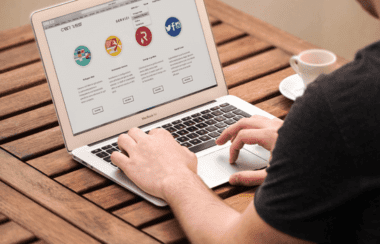How to Raise Your Rates the Right Way
By Jena Kroeker

Once upon a time, there was a freelancer who loved the ‘90s. She listened to ‘90s music, watched ‘90s television shows, and priced her freelance services like it was 1999… even though it was 2021. When asked why, she said she simply didn’t know how to raise her rates. Consequently, as time passed, her business became less profitable and more frustrating.
Although an exaggerated example, many of us can relate to the story above. If you’ve been a freelancer or virtual assistant for a while, you may just lose track of time. Years go by, and in the busyness of serving clients, you don’t realize it’s time to raise your rates.
But sadly, some freelancers don’t think they’re worth a rate increase. They underestimate their worth and the value they bring clients.
That’s a topic Freelance University co-founder Craig Cannings tackled in a previous Facebook Friday session on “How to Raise Your Rates.” He asked FreeU students two compelling questions:
• “Are you settling for less than what you deserve with your clients right now?”
• “Are you getting paid less than what you’re worth?”
As Craig says, you might be nervous about raising your rates because there’s a chance you could lose a client or make a client angry. However, the truth is we live in an inflationary world. Inflation is a part of our economy and culture, as well as freelancing. You’re not expected to charge the same amount for years because inflation happens.
In every part of business, we’re going to have to raise our rates, and there’ll be an impact. So, in this blog post, we’ll discuss how to raise your rates with new clients and existing clients the right way — with integrity.
Reasons to Raise Your Rates
In a recent FreeU blog post, “Five Mistakes to Avoid When Pricing Your Freelance Services,” we recommend reviewing and revising your rates at regular intervals to avoid pricing too low.
As you do so, consider these important reasons:
1. Inflation
Have you been paid the same rate for a long time? If so, you might have trouble covering your expenses because your income isn’t keeping pace with inflation.
2. Expanded skill sets
As time goes on, you’re providing more value to your client because you’re more skilled and experienced than when you first started. And maybe you’ve specialized in areas you weren’t working in before. You’ve expanded your scope of services and are offering clients a complementary suite of skill sets that are more niche and in-demand.
3. Busyness
Have you gotten busier over time? If you have a waiting list or are turning away business, consider the principles of microeconomics. When you have specialized services and the supply of people like you is smaller, the demand for your skills will go higher. Hence, a higher rate.
An article titled “How To Raise Your Freelance Rates So Clients Happily Say Yes To A Fee Increase” suggests some additional signals that you may be undercharging for your services as you become busier. For example, “Everyone says yes and you have nearly a 100% close rate,” and “Your hourly rate per project is decreasing.”
You may also find that “certain high-maintenance clients feel less worth the hassle because of their low-profit margin and your own daydreams of working with fewer clients that have larger budgets show up more often.”
How Do You Charge What You’re Worth?
Charging what we’re worth is an Achilles heel for many of us. We don’t know how to charge what we’re worth because we devalue what we bring to the table. We’re hard on ourselves. Maybe others have said we’re not good enough. Or we experience imposter syndrome. Negative thought patterns make us doubt our abilities.
But rest assured, you are more talented than you think. Remind yourself of that, because if you don’t believe in yourself, you’ll never charge what you’re worth.
And think of rate increases as a natural evolution in your pricing structure. It’s like an apprenticeship model in the trades. When you begin, you’ll start at a rate that’s more consistent with your skills and experience. Then, as you become more proficient, your rates will have to catch up.
For specific examples and ideas, consult resources like the Freelance Pricing Guide we provide in our “Pricing Your Freelance Services” course. It outlines a range of average rates that can be adapted to your particular clients and services as you gain experience in various niches.
Above all, you have to trust that you’re providing so much value to your client, they’d be crazy to send you on your way. Instead, they should accept that an increase will happen from time to time. Indeed, in an article titled “How (and Why) to Raise Your Freelance Rates,” Rachel Pelta says, “While nothing is guaranteed, raising your rates may not scare off your clients as much as you fear, because they don’t want to have to deal with replacing you.”
With that in mind, let’s explore some strategies for raising your rates.
How to Raise Your Rates with Existing Clients
1. Start by increasing your rates with brand-new clients.
This is an easier way to introduce new rates. For the time being, you can grandfather your old clients and only offer the increased rate to newly onboarded clients. Then, three to six months later, present the new rate to existing clients.
This strategy will build your confidence as you become accustomed to your new rate. And seeing people accept your rate will reassure you that it’s okay, and you’re indeed worth it. You’ll also feel more adequately compensated for your work. Soon, quoting the new rate won’t feel unnatural or awkward. That’s when you can think about applying it to existing clients.
2. Inform your clients well in advance.
You never want to shock your clients by saying, “Effective immediately, rates will be raised.” This is especially important with clients you’re concerned about. Don’t blindside them. Instead, give them a date when the increase will happen, for example, within the next 60 days. Let them know you’ve waited a little longer to raise their rates because of the relationship you’ve developed with them over a period of time.
This advance notice gives them time to think, process, and talk to you about it. Otherwise, they might become reactionary. The article above gives the following recommendations on how to raise your rates:
“Make sure the advance notice is in writing and easy to find. While you can put the information on an invoice, make sure you use a large enough font that stands out on an otherwise routine invoice. Consider highlighting the notification, so it’s hard to ignore.
“Also, send a separate email notification to help ensure people receive the notice. Use something obvious in the subject line like ‘Rate Increase Notification’ or ‘Change in Rates,’ to get your client’s attention.”
3. Offer existing clients a loyalty discount.
As Craig Cannings says, “All clients are not created equal.” You have top-tier clients who treat you well and others who aren’t at that level. How much you value a client will determine how you structure their rate increases. Be fair, but if you’ve been working with someone for a while, give them a special rate.
For example, if you’ve been working with a client for the past year, managing their ConvertKit, you’ve become an asset to them. So, after a year, it’s reasonable to raise your email marketing rates from $40 to $50 per hour. But consider giving long-term clients a loyalty discount of $5 per hour by charging $45 per hour. That way, you’re allowing the client to feel valued and special while still moving closer to the rate you should be charging because of your skills, talents, and experience.
The article above summarizes this strategy nicely:
“Loyalty programs are proven to generate more sales and keep customers coming back because special perks and rewards make customers feel valued and appreciated. The same strategy works in client services too. Rewarding existing clients for their loyalty generates positive, warm feelings about your relationship, services, and fees.”
4. Don’t raise your rates too sharply.
If you give a sharp increase, you’ll create greater chaos, angst, anger, and frustration among your clients. This negative backlash has a detrimental impact on the relationship. To preserve your client relationships, Craig suggests starting with a 10%, 15%, or 20% increase for existing clients — no more than 20%. But with new clients, you have a bit more latitude and could raise your rates by 25%.
5. Communicate the value of what you bring.
Now it’s time to create the script you’ll use when asking a client for an increase. This is where you’ll do a three-part recap to communicate the value of what you bring:
a) Value
First, communicate the value that you’ve brought to the existing client relationship:
“We’ve been working together for the last year, and I’ve helped you build your ConvertKit platform and taken over a lot of your email marketing tasks. And I know from what you’ve said that you’ve been happy with the services I’ve been providing so far, and it’s been a great pleasure to serve you and work with you.”
A statement like this recaps the value that you’ve brought. You could also be more specific by providing stats for how you’ve helped them increase their email list size by 50% and raised their income from email marketing efforts. Over time, take note of clients’ compliments so you can bring them back at a strategic time when you’re asking to increase your rates. If a good client has been working with you for a while, they should know your value, and you’re just articulating it and restating it.
b) Skill
Next, highlight your current skill sets, especially if you’ve expanded them:
“Over the last years, I’ve honed my skills and experiences, enabling me to complete projects and tasks more efficiently, and I’m now able to offer way more valuable services to you.”
In essence, you’re saying that you’re faster. You’re more efficient. You’re better at doing your projects and tasks. Your skills are at a higher level. Specifically, you can say,
“I’m a knowledgeable advisor to you now on all things [blank]. I hope you see me now as a trusted advisor who guides you in this area of your business.”
This statement conveys what you bring to the table as a result of skill development and experience.
c) Future Ask
Now you’ll finish with a future ask, after you’ve demonstrated the good work you’ve done with clients and the expanded skill sets you have. This is where you’ll tell them you’re raising your rates in the future:
“I want to let you know that I will be increasing my rates. I have yet to increase my rates with you. My value has been strong, my skills have been growing, and I feel like it’s time for me to do that.”
You’re not starting the increase immediately, but it’s going to happen a month or 60 days down the road. Here you prime the pump and get them ready for the increase. You might do it at set times of the year (e.g. at the beginning of a calendar year or every other year). And you can continue to make clients feel valued and special through honest statements like this:
“I just brought on two new clients who are now billing me at this rate. I’ve held off on you because of the existing relationship we have, but I know that it’s probably time to increase the rates to be consistent with what the industry is saying and with the skills and experience I have.”
Final Thoughts and Encouragement
As you can see, one part of the battle is knowing how to raise your rates. And the other part is having the confidence to do it. As you consider the strategies we’ve discussed, remember this encouragement from The VA Handbook article:
“You shouldn’t feel stressed, embarrassed or scared to raise your rates. Price rises are part of running a business and you need to appear confident about it… even if you feel the opposite.
“Remember, this is not a hobby. You’re a professional business owner.”
Do you struggle to raise your rates? Or have you taken the plunge and realized it’s not as scary as you thought? Please share your thoughts and any additional tips in the comments below!









































































































